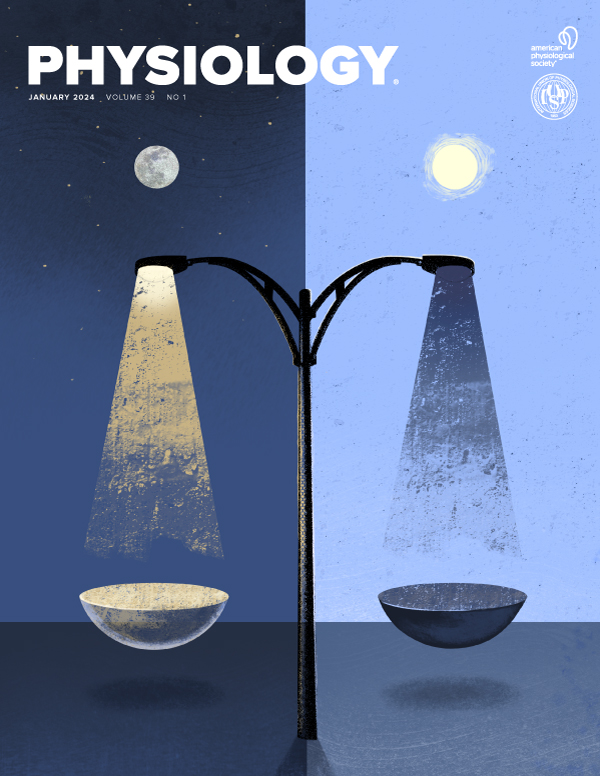爬楼梯和下楼梯一分钟可降低餐后胰岛素和血糖,三分钟可改善年轻人混合餐后的胰岛素抵抗:随机对照试验
IF 5.3
2区 医学
Q1 PHYSIOLOGY
引用次数: 0
摘要
血糖指标,包括餐后血糖、胰岛素和胰岛素敏感性,是预测糖尿病患者和非糖尿病患者发病率和死亡率的重要指标。在饮用含糖饮料(300 千卡热量;100% 碳水化合物)后,以舒适的速度爬楼梯和下楼梯(SCD)1 至 3 分钟就能改善血糖和胰岛素,胰岛素敏感性在 10 分钟内就能得到改善。目的:确定在进食含有混合宏量营养素的膳食后进行 SCD 是否会对血糖、胰岛素和胰岛素敏感性产生益处。假设:混合膳食后,SCD 将以剂量反应的方式改善血糖、胰岛素和胰岛素敏感性。研究方法在一项随机对照交叉试验中,健康状况明显良好的年轻成年人(31 人)在混合餐(650 千卡热量;53% 碳水化合物、33% 脂肪和 14% 蛋白质)后 0、1、3 和 10 分钟进行 SCD。采用混合效应方差分析法分析了血糖、胰岛素和胰岛素敏感性(ISI)从基线到 30 分钟的差异。结果:葡萄糖[F(2.551,67.17)=4.724, p=.0071)]、胰岛素[F(2.692,74.49)=11.28, p<.0001)]和 ISI [F(2.127,56.00)=5.848, p=.0042)]的变化存在明显的固定效应。与对照组相比,血糖变化(平均值(95%CI))在 1 分钟(-14(-7 至-21)毫克/分升,p=.0006)、3 分钟(-18(-9 至-28)毫克/分升,p=.0007)和 10 分钟(-10.0(-1 至-20)毫克/分升,p=.0387)后显著降低;胰岛素变化在 1 分钟(-1.8(-0.8 至-2.8)μIU/mL,p=.0011)、3 分钟(-2.8(-1.7 至-4.0)μIU/mL,p<.0001)和 10 分钟(-1.1(-0.1 至-2.0)μIU/mL,p=.0329);ISI 的变化在 3 分钟(2.4(1.2 至 3.6),p=.0003)和 10 分钟(1.3(0.3 至 2.4),p=.0143)后明显升高,但在 1 分钟(1.2(0.0 至 2.5),p=.0587)后没有明显升高。结论表面上健康的年轻人在进食混合餐后,以自选、舒适的速度进行 SCD,只要 1 分钟就能改善餐后血糖和胰岛素,只要 3 分钟就能改善胰岛素抵抗。无。本文是在 2024 年美国生理学峰会上发表的摘要全文,仅提供 HTML 格式。本摘要没有附加版本或附加内容。生理学》未参与同行评审过程。本文章由计算机程序翻译,如有差异,请以英文原文为准。
One minute of stair climbing and descending reduces postprandial insulin and glucose with three-minutes improving insulin resistance following a mixed meal in young adults: A Randomized Controlled Trial
Glycemic markers, including postprandial glucose, insulin, and insulin sensitivity, are strong predictors of morbidity and mortality in individuals with and without diabetes. Stair-climbing and -descending (SCD) at a comfortable pace for as little as 1 to 3 minutes after a sugary beverage (300 kilocalories; 100% carbohydrate) improves glucose and insulin, with insulin sensitivity improving with as little as 10 minutes. Objective: To determine if benefits to glucose, insulin, and insulin sensitivity are seen with SCD following consumption of a meal with mixed macronutrients. Hypothesis: SCD will improve to glucose, insulin, and insulin sensitivity in a dose response manner following a mixed meal. Methods: In a randomized, controlled, crossover trial, young adults (N=31) in apparent good health performed SCD for 0, 1, 3, and 10 minutes after a mixed meal (650 kilocalories; 53% carbohydrates, 33% fat, and 14% protein). Differences in glucose, insulin, and insulin sensitivity (ISI) from baseline to 30 minutes were analyzed using a mixed-effects ANOVA. Results: A significant fixed-effect was found for change in glucose [F(2.551,67.17)=4.724, p=.0071)], insulin [F(2.692,74.49)=11.28, p<.0001)], and ISI [F(2.127,56.00)=5.848, p=.0042)]. Compared to control, changes in glucose (mean (95%CI)) were significantly lower after 1 min (-14 (-7 to -21) mg/dL, p=.0006), 3 min (-18 (-9 to -28) mg/dL, p=.0007), and 10 min (-10.0 (-1 to -20) mg/dL, p=.0387); changes in insulin were significantly lower after 1 min (-1.8 (-0.8 to -2.8) μIU/mL, p=.0011), 3 min (-2.8 (-1.7 to -4.0) μIU/mL, p<.0001), and 10 min (-1.1 (-0.1 to -2.0) μIU/mL, p=.0329); and changes in ISI were significantly higher after 3 min (2.4 (1.2 to 3.6), p=.0003) and 10 min (1.3 (0.3 to 2.4), p=.0143) but not 1 min (1.2 (0.0 to 2.5), p=.0587). Conclusion: Postprandial glucose and insulin were improved with as little as 1 minute, and insulin resistance improved with as little as 3 minutes, of SCD at a self-selected, comfortable pace, after consumption of a mixed meal in apparently healthy young adults. None. This is the full abstract presented at the American Physiology Summit 2024 meeting and is only available in HTML format. There are no additional versions or additional content available for this abstract. Physiology was not involved in the peer review process.
求助全文
通过发布文献求助,成功后即可免费获取论文全文。
去求助
来源期刊

Physiology
医学-生理学
CiteScore
14.50
自引率
0.00%
发文量
37
期刊介绍:
Physiology journal features meticulously crafted review articles penned by esteemed leaders in their respective fields. These articles undergo rigorous peer review and showcase the forefront of cutting-edge advances across various domains of physiology. Our Editorial Board, comprised of distinguished leaders in the broad spectrum of physiology, convenes annually to deliberate and recommend pioneering topics for review articles, as well as select the most suitable scientists to author these articles. Join us in exploring the forefront of physiological research and innovation.
 求助内容:
求助内容: 应助结果提醒方式:
应助结果提醒方式:


